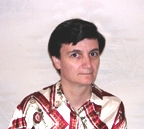|
President's
Second Message
|
||
 Marie-Geneviève Barthés-Labrousse President - IUVSTA (2001-2004) Triennium |
||
Dear
Colleagues, The first full Executive Council Meeting (ECM
90) of the current triennium was held last March in Regensburg, Germany.
It was the first occasion for new Councillors to participate to the
many activities in which our Union is engaged. The excellent attendance
observed at this first meeting allowed fruitful debates to be held in
all Committee Meetings and several decisions have already been taken.
In particular, support to several new scientific workshops and schools
has been agreed by the ECM.
The educational program is a strong and long-standing
component of the IUVSTA activities and comprises various aspects. For
example, every year since 1968, the Medard W. Welch scholarship is awarded to a student to undertake
a one-year postgraduate study on a vacuum-related topic in a country
different from his/her country of origin. Another achievement resulted
from fruitful collaboration with various organisations which lead to
the establishment of the IUVSTA Schools. Since the first School on the
Science and Technology of Thin Films, held at the International Centre
for Theoretical Physics (ICTP) in Trieste, Italy, in 1994, several Schools
have been organised, with an emphasis on students from lesser developed
countries. The next one, related to Photovoltaic materials and devices,
is planned in Mexico, in autumn 2003. Short courses on vacuum technology
and related topics are also offered since 1994, linked with IUVSTA events
such as the International Vacuum Conference (IVC), the International
Conference on Thin Films (ICTF) or the European Vacuum Conference (EVC).
Finally, the Visual Aids Program is in constant expansion. It started
in 1971 with a slide version of five modules. The series was later updated
and expanded into eleven modules of overhead transparencies. A constant
reviewing and updating of this material is necessary to meet the quality
required by modern standards of communication and to make all the modules
available in the electronic format. This has already been achieved for
the module on Thin Film Deposition and I trust new modules will soon
become available.
All these achievements give clear evidence of
the vitality of the IUVSTA educational program and of the enthusiasm
and dedication of people who involved themselves in these activities
and I feel confident that they will continue to flourish. However, I
am convinced that, in spite of the modest income of the Union, our activity
in the field of education can be further increased.
A more extensive use of our Website can provide
a simple way to disseminate technical information at low-cost. Technical
web pages can include tables and simple databases (e.g. vapour pressures…)
but also animated material (e.g. ion sputtering, rough pump working…).
They may be designed at different levels of complexity, to be useful
to students and beginners as well as to experts. A first quick and costless
step would be to identify and link to already existing material. Further
development will require designing and mounting new pages. In addition,
the possibility to link to these pages and/or to translate them in local
languages for implementation on their own Website may be offered as
a service to our society members. This should help both the dissemination
of the information and the visibility of the Union and its members.
A long-standing question which often arose in
the past years was how IUVSTA can provide help for Developing Countries.
Due to the very small amount of money that our Union can devote to any
activity, it has been difficult, so far, to identify any action which
would provide valuable support to these countries. It arose from recent
discussions that most of the need was in the field of education and
helping national Vacuum Societies to run technical schools at basic
level may be a first approach. It seems that even a small amount of
money, such as 1000 Swiss Francs, can be of significant help on the
organisation of local Technical Schools, given in local languages with
local instructors. Thus I trust that special attention will be given
by the Education Committee to proposals from Vacuum Societies from Developing
Countries to run such courses.
These are only examples of possible developments
of the Union educational activities. I would welcome any further suggestion
as, I am sure, would Joe Greene, as Chair of the Education Committee.
Finally, I take the opportunity to remind you
that you can keep informed of the activities of the Union by regularly
consulting our Web pages.
Marie-Geneviève
Barthés-Labrousse July
2002 |
|
|
 |